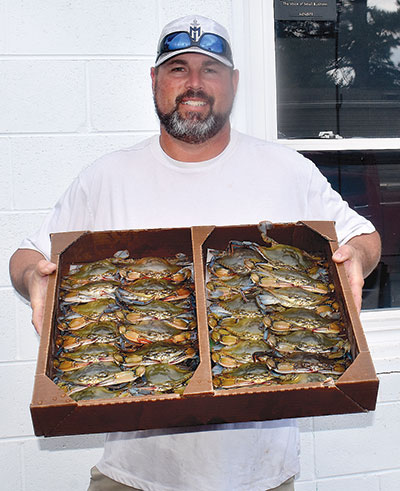A joyous sign of spring and summer is the clusters of small crab sheds lying along the shorelines and marshes of the creeks and coves of the Rappahannock and Piankatank rivers. The sheds mark the arrival of the blue crab soft-shell crab season.

Fried soft-shell crabs are a seafood fare that local watermen are now chasing down to supply for the local seafood market and the east coast markets of Philadelphia, Boston, Washington, D.C., Baltimore and New York.
Joey Williams of T.M. Williams & Son Seafood Inc. of Remlik catches his crabs in peeler pots (non-baited pots). On Monday at his business on Streets Road in Remlik, he pulled out a box full of “whales” (large soft-shells) from his cooler that are soon to be shipped to the New York market. The crabs are packaged in a two sectioned cardboard box, each section holding a dozen crabs, and covered with wet newspaper for shipping. “We caught these on the Piankatank River and they are big enough to pull a plow,” he said jokingly.
Williams has been fishing for three weeks on the Piankatank and he is moving this week to the Rappahannock River as catches are slowing down and word is that Rappahannock crabs are starting to shed.
Watermen chase down “runs” of crabs, which is the term used when large numbers of crabs start shedding. The run on the Piankatank started about three weeks ago. The Rappahannock run is just starting.
As the runs move, watermen trailer their boats and gear to the different rivers. “We are moving back to the Rappahannock, because we were told watermen are starting to catch green peelers there and the run has slowed down on the Piankatank,” said Williams.
Blue crabs grow by molting or shedding the hard exoskeleton, or shell. Each time a crab sheds, it comes out considerably larger. Right after shedding, the shell and meat of the crab are very soft and quite delicious when fried.
A peeler crab is a crab in one of the three stages just prior to shedding. Watermen harvest peelers and place them in holding units to wait for them to shed into soft-shells. The three stages are green (earliest stage of molting), medium (about halfway), and ripe (ready to bust open). When a crab is about halfway through busting it is called a buster.
Williams said the price was good early on for his crabs. “We got ‘through the roof’ prices that first week and then the North Carolina run started.”
Traditionally in the early spring North Carolina peeler crabbers get the best price for soft-shell crabs because the runs start earlier than on Chesapeake Bay. This year, Chesapeake runs started a week sooner than North Carolina. “Once the Carolina runs start the price goes down,” said Williams.
“We had a good run on the Piankatank, but we are noticing that each year the runs are not lasting as long,” he said.
Soft-shells can be purchased locally at Norman’s Produce in Saluda. Brittany Craddock of Norman’s said this week that they have locally caught crabs for sale.
Norman’s crabs are supplied by Tony Walton’s Seafood of Urbanna and crabber Clyde Stewart of Kilmer’s Point. “When we put that soft crab sign up business really picks up,” she said. “It’s a sign that spring has come and winter is finally over.”
Norman’s crabs are priced by the piece. A medium size soft-shell is $2.25; a hotel, $3; and a prime, $4.25 a piece. Whales have to be pre-ordered, she said.



